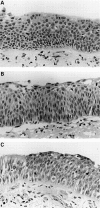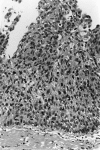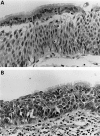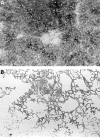Pulmonary preinvasive neoplasia
- PMID: 11304841
- PMCID: PMC1731391
- DOI: 10.1136/jcp.54.4.257
Pulmonary preinvasive neoplasia
Abstract
Advances in molecular biology have increased our knowledge of the biology of preneoplastic lesions in the human lung. The recently published WHO lung tumour classification defines three separate lesions that are regarded as preinvasive neoplasia. These are (1) squamous dysplasia and carcinoma in situ (SD/CIS), (2) atypical adenomatous hyperplasia (AAH), and (3) diffuse idiopathic pulmonary neuroendocrine cell hyperplasia (DIP-NECH). SD/CIS is graded in four stages (mild, moderate, severe, and CIS), based upon the distribution of atypical cells and mitotic figures. Most airways showing SD/CIS demonstrate a range of grades; many epithelia are hard to assess and the reproducibility of this complex system remains to be established. Detailed criteria are, however, welcome and provide an objective framework on which to compare various molecular changes. Alterations in gene expression and chromosome structure known to be associated with malignant transformation can be demonstrated in CIS, less so in dysplasias, but also in morphologically normal epithelium. The changes might be sequential, and their frequency and number increase with atypia. Less is known of the "risk of progression" of SD/CIS to invasive "central" bronchial carcinoma. It may take between one and 10 years for invasion to occur, yet the lesion(s) may be reversible if carcinogen exposure ceases. AAH may be an important precursor lesion for peripheral "parenchymal" adenocarcinoma of the lung: the "adenoma" in an adenoma-carcinoma sequence. There is good morphological evidence that AAH may progress from low to high grade to bronchioloalveolar carcinoma (BAC; a non-invasive lesion by definition). Invasion then develops within BAC and peripheral lung adenocarcinoma evolves. The molecular events associated with this progression are not well understood and studies are hampered by a lack of clear criteria to distinguish high grade AAH from BAC. Nonetheless, as with SD/CIS, the patterns of expression of tumour associated genes are consistent with neoplastic progression. We have little idea of the incidence of AAH in the normal or "smoking" populations. It is found more frequently in cancer bearing lungs, especially in those with adenocarcinoma, and is more common in women. No data are available on the risk of progression of AAH. DIPNECH is an exceptionally rare lesion associated with the development of multiple carcinoid tumours. Almost nothing is known of its biology. Knowledge of these lesions will be crucial in the design and understanding of lung cancer screening programmes, where it is likely that the morphological and, more importantly perhaps, the molecular characteristics of these lesions will provide useful targets for detection and possibly even treatment.
Figures








Similar articles
-
The significance of associated pre-invasive lesions in patients resected for primary lung neoplasms.Eur J Cardiothorac Surg. 2004 Jul;26(1):165-72. doi: 10.1016/j.ejcts.2004.03.044. Eur J Cardiothorac Surg. 2004. PMID: 15200997
-
Disproportionate representation of KRAS gene mutation in atypical adenomatous hyperplasia, but even distribution of EGFR gene mutation from preinvasive to invasive adenocarcinomas.J Pathol. 2007 Jul;212(3):287-94. doi: 10.1002/path.2165. J Pathol. 2007. PMID: 17534846
-
[Preneoplastic lesions of pulmonary carcinoma].Pathologe. 2011 Nov;32 Suppl 2:218-23. doi: 10.1007/s00292-011-1527-y. Pathologe. 2011. PMID: 22033683 Review. German.
-
Pulmonary preneoplasia--sequential molecular carcinogenetic events.Histopathology. 2009 Jan;54(1):43-54. doi: 10.1111/j.1365-2559.2008.03182.x. Histopathology. 2009. PMID: 19187179 Review.
-
Expression of Fhit, cell adhesion molecules and matrix metalloproteinases in atypical adenomatous hyperplasia and pulmonary adenocarcinoma.J Pathol. 2004 Jun;203(2):638-44. doi: 10.1002/path.1557. J Pathol. 2004. PMID: 15141378
Cited by
-
PR-Set7 is Degraded in a Conditional Cul4A Transgenic Mouse Model of Lung Cancer.Zhongguo Fei Ai Za Zhi. 2015 Jun;18(6):345-50. doi: 10.3779/j.issn.1009-3419.2015.06.15. Zhongguo Fei Ai Za Zhi. 2015. PMID: 26104890 Free PMC article.
-
Management of Diffuse Idiopathic Pulmonary Neuroendocrine Cell Hyperplasia: Review and a Single Center Experience.Lung. 2018 Oct;196(5):577-581. doi: 10.1007/s00408-018-0149-z. Epub 2018 Aug 25. Lung. 2018. PMID: 30167840 Review.
-
Lung Krüppel-like factor (LKLF) is a transcriptional activator of the cytosolic phospholipase A2 alpha promoter.Biochem J. 2005 Apr 1;387(Pt 1):239-46. doi: 10.1042/BJ20041458. Biochem J. 2005. PMID: 15540987 Free PMC article.
-
Lung Cancer in the Course of COPD-Emerging Problems Today.Cancers (Basel). 2022 Aug 6;14(15):3819. doi: 10.3390/cancers14153819. Cancers (Basel). 2022. PMID: 35954482 Free PMC article. Review.
-
NTCU induced pre-malignant and malignant stages of lung squamous cell carcinoma in mice model.Sci Rep. 2021 Nov 18;11(1):22500. doi: 10.1038/s41598-021-01988-8. Sci Rep. 2021. PMID: 34795360 Free PMC article.
References
Publication types
MeSH terms
LinkOut - more resources
Full Text Sources
Other Literature Sources
Medical
